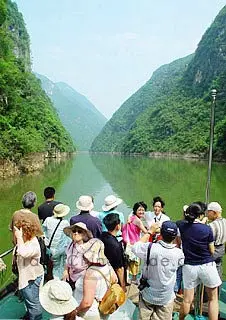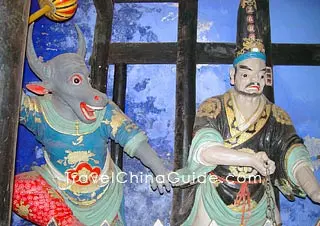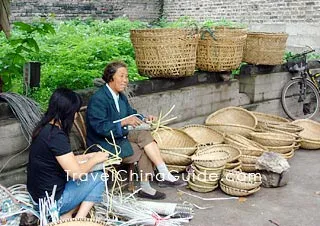How does Yangtze River civilization affect China?
 Yangtze River civilization, especially the rice-planting culture, has far-reaching influences on East Asian civilization and even world civilization. It is the general name for the civilizations of various regions in the Yangtze River Basin. Yangtze civilization started in around 5,000 BC more than 7,000 years ago. It tops among world’s ancient civilizations for the wide area and densely distributed a large amount of cultural sites.
Yangtze River civilization, especially the rice-planting culture, has far-reaching influences on East Asian civilization and even world civilization. It is the general name for the civilizations of various regions in the Yangtze River Basin. Yangtze civilization started in around 5,000 BC more than 7,000 years ago. It tops among world’s ancient civilizations for the wide area and densely distributed a large amount of cultural sites.
Yangtze River civilization is also considered as one of the two sources of Chinese civilization together with Yellow River civilization. Yangtze River Valley civilization, Yellow River civilization and other ancient Chinese civilizations have influenced each other and merged together in long time, eventually forming the Chinese civilization.
Timeline of Yangtze River Civilization
Since the discovery of Yangshao Culture on the banks of Yellow River in the beginning of the 20th century, Yellow River Basin has been considered as the birthplace of Chinese civilization, for most of the Yangshao relics have appeared here. Then as time went by, Yellow River civilization was spread to surrounding areas including the Yangtze River Basin.
However, this mainstream view was subverted by the discoveries of Majiabang site in the early spring of 1959 in Nanhu Township, Jiaxing, and Hemudu site unearthed from 1973 to 1978 in Yuyao, both in the lower reaches of Yangtze River. The Luojiajiao site acknowledged in the early days of the Majiabang culture was about 7,000 years old. Hemudu culture was presumed to be from about 5,000 BC to about 3300 BC, as rice had been planted in large quantities.
The discoveries prove that Yangtze River civilization is unique, not inherited from Yellow River civilization. So far, the dogmas of “Yellow River civilization is Chinese civilization” has been overthrown gradually and people started to know Yangtze River civilization is equally important in Chinese civilization.![]() Read More: Yangtze Culture Evolution
Read More: Yangtze Culture Evolution
Prehistoric Yangtze River Civilization
Not a few ancient Yangtze River Valley civilizations developed along the river, and the representative prehistoric ones include Liangzhu, Hemudu, Wucheng, Pengtoushan, Qujialing, Shijiahe, Daxi Cultures, etc.
Liangzhu Culture: Zhejiang, Jiangsu & Shanghai
Originating from 4,300-5,300 years ago, Liangzhu Culture covered Qiantang River Basin and Taihu Lake Area, and centered in Pingyao Town, northwest of Hangzhou, where serried sites were discovered with a large number of diverse jade wares unearthed. Marvelous pottery is another characteristic of Liangzhu Culture. Meanwhile, Liangzhu people planted kinds of rice with stone tools, and crafted wares and wove cloth with bast fibers and silk to a high level of perfection. On July 6, 2019, the Archaeological Ruins of Liangzhu City were listed as a World Heritage.
Hemudu Culture: East Zhejiang
Hemudu Culture is typical neolithic Yangtze River civilization with many cultural achievements. It is a matriarchal clan society, firstly unearthed in Yuyao, Ningbo, Zhejiang Province in 1973, and distributed in Ningshao Plain, the south bank of Hangzhou Bay, and Zhoushan Islands. Hemudu Culture can be dated back to 5,000-3,300 BC about 7,000 years ago, creating black pottery and pole-railing style houses, which became one of the main styles of folk house in South China later. They could also make exquisite tools with bones and plant rice.
| Yangtze River Trackers |
Pengtoushan Culture: North Hunan
Pengtoushan Culture is also a quite ancient Yangtze River Valley civilization. Dated to about 8,300-9,000 years ago, it is the earliest Neolithic culture in the Yangtze River Basin. Although the pottery there is rough, archaeologists found the earliest rice husks and rice grains in the world. That’s to say, the middle and lower reaches of Yangtze play an extremely important role in the source and development of rice planting.
Qujialing Culture: Hubei
Qujialing Culture dated to about 3,300-2,600 BC was re-discovered in Jingshan, Hubei in 1955. According to the archaeological discoveries, Qujialing Culture can be divided into former and later periods. In the former period, people could make rough stone tools and black pottery, gray, yellow and red pottery were less. In the later period, stone tools were better. Qujialing people reared pigs and dogs, too.
Daxi Culture: Sichuan, Chongqing & Hubei
Daxi Culture is another Yangtze civilization in Neolithic Age, covering both banks along the Yangtze River from eastern Sichuan to central and southern Hubei. We can go back to about 4,400-3,300 BC to find it was a kind of civilization featured with red pottery and a small amount of colored pottery. People there, at that time, not only planted rice, but also raised pigs, dogs, chickens, cows and sheep.![]() See Also: Daxi Culture Heritage Site
See Also: Daxi Culture Heritage Site
Different Cultures Originated along the Yangtze River from West to East China
Ba-Shu Culture: Chongqing & Sichuan
Ba-Shu Culture, a kind of Yangtze River Valley civilization, consists of Ba Culture and Shu Culture, originating from Chongqing and Sichuan respectively. The two cultures merged into a whole gradually after Warring States Period (475-221 BC), combined elements of Confucianism, Taoism, Buddhism and varied local ethnic cultures. There is a close relationship with China’s central plain culture, even as it maintains its own uniqueness.
 |
| Fengdu Ghost City |
Sanxingdui Culture: Sichuan
Sanxingdui Culture re-distributed mainly in Sichuan province was discovered in the 20th century. It is a subgroup of earlier Shu Culture, existing in about 2,800-1,100 BC. The relics unearthed there are oddly shaped, and differ from others. The most remarkable relics are huge bronze trees and bronze statues, proving that earth worship had an important position.![]() See Also: Sanxingdui Museum
See Also: Sanxingdui Museum
Chu Culture: Mainly in Hubei & Hunan
Chu Culture is the culture originating from Chu State in Spring and Autumn Period (770 - 476 BC) and Warring States Period (475 - 221 BC), a vital part of Yangtze civilization as well as the whole Chinese civilization. The literary and art achievements of Chu Culture are widely influential. In the earlier stage, Hubei and southwest Henan were the center of Chu Culture; after the mid-Spring and Autumn Period, the center moved to Hunan and Jiangxi; and in the later stage, its center was in north Anhui, north Jiangsu and southeast Henan. Chu Culture influenced Guizhou, Yunnan, Guangdong and other surrounding regions as well.
Gan Culture: Jiangxi
 |
| Bamboo Weaved Products |
Gan Culture is the culture in Jiangxi, which came from Yue Culture and Wu Culture mentioned below. Under Gan Culture, unique cultural systems of porcelains, academies, poems, paintings, Confucianism, Buddhism, etc. sprung up. Since ancient time, Gan Culture nurtured a plenty of masters, such as Tao Yuanming, Wang Anshi and Ouyang Xiu. Up to modern times, the Soviet culture added a new chapter to the unfading Gan Culture.
Wu Culture: south Jiangsu & north Zhejiang
The influential region of Wu Culture is the surrounding areas of Taihu Lake, including south Jiangsu and north Zhejiang; and south Jiangsu is the birthplace and key area of Wu Culture. Based on the civilization of Wu State before Warring States Period (475-221 BC), Wu Culture developed for thousands of years and reached its peak in Ming Dynasty (1368-1644 AD). Compared with other Yangtze civilizations, Wu Culture has an obvious feature of sea transportation. The local opera, crafts, carving, painting and gardens became great characteristic features of Wu Culture.
Yue Culture: east Zhejiang
Yue Culture refers to the cultural remains left by the Yue State in Eastern Zhou Dynasty (770 - 256 BC). Centered on Kuaiji Mountain in Shaoxing in east Zhejiang and south of Hangzhou Bay, it is influenced by Hemudu Culture, Liangzhu Culture and so on. Yue Culture is mainly reflected in folk customs, arts and academic aspects. Yue people prefer to be brave and outgoing with a spirit of adventure; they admire nature.![]() Further Reading:
Further Reading:
Yangtze River Crafts